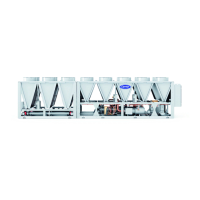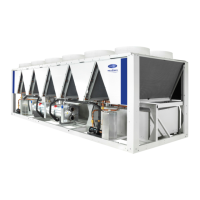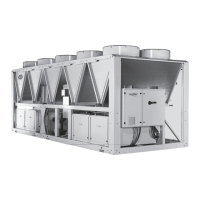43
Nb is the number of samples the controller uses to determine if
unit is stable. One sample is taken per second. Optimization
Deviation Tolerance is the percentage change in the capacity
which will trigger the controls to get out of optimization and re-
optimize. The Optimization Disturbance Period is the time it
waits after fan frequency adjustment to determine if the unit is
optimized or needs further iteration. Optimization Freeze Pow-
er Tolerance is the Power delta tolerance to determine if the op-
timum is met or not. If power change is lower than that with
fan frequency change then it is considered as an optimal point.
The Optimization filter time is the filter time of the fan power
to eliminate power measurement noise.
Fan control continuously monitors all inputs and outputs
and the transitions between the modes are defined based on
continuous measurements of 2 inputs (Discharge Pressure
and Discharge Gas Temperature). Fan modes of operation
include the following:
• STANDARD: Normal mode of operation before using
the optimum-seeking algorithm.
• WAITOPT, OPTIMZE: Trying to optimize the fan fre-
quency during the optimum-seeking algorithm.
• FREEZE: Fan frequencies are frozen after completion of
the optimum-seeking algorithm cycle. The fan control
remains in this mode until the LWT, the compressor load,
or the outdoor temperature changes by a defined amount.
If the change conditions are met the fan control goes
back to the WAITOPT mode followed by the OPTIMZE
modes.
• DGT: High Discharge Gas Temperature mode. The VFD
increases the speed of the fan to reduce DGT.
• DP_HIGH, DP_LOW: High Discharge Pressure Mode,
Low Discharge Pressure Mode: The VFD controls the
speed of the fan to bring SCT into normal operating
range.
• OFF: Fans are not running.
• START: Start mode. The frequency of the fans is defined
based on the OAT.
Head Pressure Control (Fixed Speed
Fans) — The head pressure is controlled through the
Touch Pilot display by adjusting the number of fans run-
ning. The controller determines the minimum number of
fans required to support unit operation so the unit can run
at the most efficient point. At start up the number of fans
on is calculated using OAT. After 60 seconds, an equation
is used to determine the number of fan required based on
OAT, EWT, and circuit capacity.
There are additional modes used for fixed speed fans:
DP High — Mode decreases the discharge pressure as fast
as possible to prevent high pressure trips. This mode turns
on all fans.
DP High Discharge Pressure — Mode avoids high dis-
charge pressure that would cause the compressor to run out-
side of the compressor envelope. In this mode, the pressure
is controlled to a Discharge Pressure set point.
DGT High — Mode decreases the discharge temperature as
fast a possible to prevent high DGT alarms. This mode turns
on all fans.
PRE-START-UP
Do not attempt to start the chiller until the following checks
have been completed.
System Check
1. Check that auxiliary components, such as the chilled
fluid circulating pump, air-handling equipment, or oth-
er equipment to which the chiller supplies liquid are
operational. Consult manufacturer’s instructions. If the
unit has field-installed accessories, be sure all are
properly installed and wired correctly. Refer to unit
wiring diagrams.
2. Open compressor suction service valves (if equipped).
3. Open discharge line, liquid line, oil line, and economizer
(if equipped) service valves.
4. Fill the chiller fluid circuit with clean water (with recom-
mended inhibitor added) or other non-corrosive fluid to be
cooled. Bleed all air out of high points of system. If out-
door temperatures are expected to be below 32 F (0° C),
sufficient inhibited propylene glycol or other suitable cor-
rosion inhibited antifreeze should be added to the chiller
water circuit to prevent possible freeze-up.
The chilled water loop must be cleaned before the unit is
connected. It is recommended that the chiller pumps be
equipped with a start-up filter screen to remove particu-
lates from the loop. The start-up filter should be replaced
after 24 hours of operation
5. Check tightness of all electrical connections.
6. Electrical power source must agree with unit nameplate.
7. Oil separator heaters must be energized for 24 hours prior
to start-up.
START-UP
Actual Start-Up —
Actual start-up should be done only
under supervision of a qualified refrigeration technician.
1. Be sure all oil, suction valves, discharge valves (if
equipped) and liquid line service valves are open.
2. Using the Touch Pilot control, set leaving-fluid set point
(Main Menu Setpoint Table Cooling Setpoint 1).
No cooling range adjustment is necessary.
3. If optional control functions or accessories are being
used, the unit must be properly configured. Refer to
Configuration Options section for details.
4. Start the chilled fluid pump, if unit is not configured for
pump control (Main Menu Configuration Menu
Pump Configuration Evaporator Pumps Sequence = 0).
5. Complete the Start-Up Checklist to verify all components
are operating properly.
6. Press the Start/Stop button located in the upper right
corner of the Touch Pilot display and then select Local On.
7. Allow unit to operate and confirm that everything is func-
tioning properly. After unit operation stabilizes, check to
see that leaving set-point Control Point (Main Menu
Setpoint Table Cooling Setpoint 1) agrees with leaving
fluid temperature (Main Menu Temperatures Evap
Leaving Fluid).
IMPORTANT: Complete the Start-Up Checklist for
30XV Liquid Chillers at the end of this publication.
The checklist assures proper start-up of a unit, and
provides a record of unit condition, application
requirements, system information, and operation at
initial start-up.

